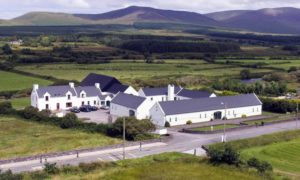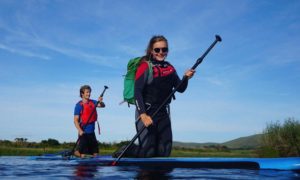Blue print for the revitalisation of the Uíbh Ráthach Gaeltacht launched

A blueprint for the revitalisation of the Uíbh Ráthach Gaeltacht in south Kerry, that has been developed as a model to be used for other rural revitalisation projects, has been issued by Údarás na Gaeltachta on behalf of the Uíbh Ráthach Interagency Taskforce, and was launched by Government Chief Whip and Minister of State for Gaeilge, the Gaeltacht and the Islands, Seán Kyne T.D. on Monday (22/7/19).
Highlights include:
- 145 new full-time jobs to be created
- New gteic innovation & digital hub to be developed in Baile an Sceilg
- 3% increase in population
- Attract 10 new families to live in the area
- 20 houses to be made available for purchase or long term lease
- 15 apprenticeship places per year
- 20 alternative farm enterprises to be established
- 10% increase in visitors to the area
- 20% increase in Tourism accommodation all year round
- Implement Plean Teanga Chiarraí Theas
- 5% increase in daily Irish speakers
- Re-establish Irish language summer college
- Reinstate 24-hour helicopter emergency hospital transfer

The Report and Action Plan of the Uíbh Ráthach Gaeltacht Interagency Taskforce, set out 100 challenging, realistic, time-specific measures aimed at addressing the severe population loss, ageing demographic profile and economic decline which has been experienced in the Uíbh Ráthach Gaeltacht over recent decades. The Action Plan has been produced at the initiative of the Gaeltacht Community of Uíbh Ráthach and with the support of Government Ministers, Government Departments, public representatives and various state and local agencies and organisations.
The Interagency Task Force, set up in Uíbh Ráthach in September 2017 under the stewardship of Údarás na Gaeltachta, is unique and it is hoped that it can provide a template for other areas throughout Ireland which are under similar pressures and identifies a collaborative methodology and model which will help to address the issues in such areas.
.It was recognised that the Uíbh Ráthach Action Plan needed to be prepared using a collaborative process.
From the outset, it was recognised that the Uíbh Ráthach Action Plan needed to be prepared using a collaborative process involving government departments, state agencies, local government, local development bodies, the private sector and community organisations amongst others. It was also recognised, that the Action Plan was being developed in the context of the cultural importance of the Uíbh Ráthach Gaeltacht and that the focus was on the social and economic conditions of the area, which were contributing to population decline and threatening the future of the Gaeltacht as a functioning entity.
The Action Plan therefore has a specific social and economic focus – with a distinct cultural purpose.
.
Plan Focus
The two key areas of focus of the Action Plan are employment and the quality of life in the area. The Uíbh Ráthach Action Plan reflects the Action Plan for Rural Development, its structure and format and outlines a wide range of specific, measurable, achievable measures that are focused on the five pillars as outlined below. In addition, the plan sets out in detail the parties responsible for the implementation of each measure and clearly outlines the time-scale for implementation in each case.
Key Targets & Actions
The Plan outlines over 35 objectives and 100 specific measures that will be implemented in conjunction with over 25 stakeholders. The Action Plans key targets are as follows
Supporting Sustainable Communities
- 3% increase in population
- Attract 10 new families to live in the area
- 20 houses to be made available for purchase or long term lease
- Develop a plan for marketing the area as a place to live for the quality of life on offer
Supporting Enterprise and Employment
- 145 new full-time jobs to be created
- 75 jobs supported by Údarás na Gaeltachta in new private & public enterprise space
- 40 jobs in alternative farm enterprises supported by Teagasc
- 30 jobs created using the natural resources of the area supported by various agencies
- New gteic innovation & digital hub to be developed by Údarás na Gaeltachta in Baile an Sceilg
- 20 alternative farm enterprises to be established and supported by Teagasc
- 15 apprenticeship places per year supported by Kerry ETB
Fostering Culture and Creativity in Rural Communities
- Implement Plean Teanga Chiarraí Theas (South Kerry Language Plan)
- 5% increase in daily Irish speakers
- Reestablish an Irish Language College in the Area supported by the Department of Culture, Heritage and the Gaeltacht.
Maximising our Rural Tourism and Recreation Potential
- 10% increase visitors to the area
- 20% increase in Tourism accommodation all year round
Improving Rural Infrastructure
- Reinstate 24-hour helicopter emergency hospital transfer
- Investigate differential tax subsidies as an incentive to locate in the area

Implementation
An Implementation Steering Group will be established as an overall umbrella group representative of key organisations and the community and will be a linkage forum for the various parts of the Action Plan. The Steering Group will act on behalf of the Task Force when such is required and will also develop Annual Action Plans and set priorities.
The Department of Rural and Community Development recently approved funding for the development of projects identified in the Action Plan for Uíbh Ráthach. The funding will support the implementation of the plan, central to which is the employment of a Project Manager to coordinate the implementation of the plan for a 3-year period. Údarás na Gaeltachta will match fund and line manage the Project Manager who will be based in the Uíbh Ráthach Gaeltacht.
To that end, Kathleen Breathnach of Cnopóg, An Dromad in Uíbh Ráthach has been appointed as Project Manager for the plan and has commenced duties in recent days. Kathleen has spent 18 years working as the manager of Comhchoiste Ghaeltacht Uíbh Ráthaigh and was employed as a facilitator to the task force during the preparation of the plan.
Further Information
Background
Having observed worrying trends of both the Irish language and the dwindling population in Uíbh Ráthach, the local community identified and articulated a need for concerted action. The Uíbh Ráthach community and Comhchoiste Uíbh Ráthach, on foot of commissioned research into the declining demographics of the area, requested that special steps be taken to address the issues facing the area such as population decline, ageing demographic social and economic decline.
On foot of agreement from the main departments and agencies, the Interagency Taskforce for the Uíbh Ráthach Gaeltacht was established and held its first meeting on the 4 September 2017 in Baile an Sceilg. The newly established taskforce gained national recognition and momentum immediately being included as a deliverable action of the Action Plan for Rural Development, which was in preparation at the time and in various other national and state agency strategies thereafter.
Taskforce Membership
Údarás na Gaeltachta (Chair & Secretariat) / Department of Culture, Heritage and the Gaeltacht / Kerry County Council / Coillte / Kerry Education and Training Board / Coláiste na Sceilge / Kerry Leo / Comharchumann Naomh Fhionáin / Local Link Kerry / Comhchoiste Ghaeltacht Uíbh Ráthaigh / Mary Immaculate College (Limerick) / Department of Rural and Community Development / Skelligs Chocolate / Department of Social Protection / Skellig Coast Tourism Network / Éigse na Brídeoige / Skellig CRI / Enterprise Ireland / South Kerry Development Partnership CLG / Fáilte Ireland / Teagasc / IT Tralee / University College Cork
Terms of Reference
The Task Force was challenged with the responsibility of developing an integrated, cross-sectoral plan for the Uíbh Ráthach area in order to
- revitalise the area to attract enterprise and investment
- address the significant decline in the population of the area
- address both the social and economic needs of the community in accordance with the five pillars and objectives of the Action Plan for Rural Development
- be aligned to the 20-Year Strategy for the Irish Language 2010-2030, Údarás na Gaeltachta’s Strategic Plan 2018-2020, the County Kerry Local Economic and Community Plan 2016-2021 and with relevant Southern Regional Assembly plans
It is noted therefore that the Action Plan reflects the Action Plan for Rural Development and its structure and format, adopting the pillars of that Action Plan.
Strategic Goals & Targets
The Action plan sets out four overarching strategic goals and associated targets as follows –
Strategic Goal Target
1 a. Stabilise and then increase the population in the area • Population increased by 3% (50)
- 10 new families living in the area
- Long-term population increase to 2,100
1 b. Improve the population structure in the area • Increase youth dependency by 6% in the longer term
- Reduce elderly dependency by 6% in the longer term
- Increase Population Vitality by 6% in the longer term
1 c. Increase employment opportunities in the area
- Create 145 new FTE jobs to cater for new families and existing underemployment with
- Develop a gteic digital hub in the Uíbh Ráthach Gaeltacht to allow people to work in a creative co-working environment
1 d. Improve the structure of employment in the area • Increase percentage of manufacturing and services and commerce jobs by 20% each
1 e. Retain and re-instate the key quality of life services that a sustainable community requires • Cahersiveen Garda station fully staffed, resourced and operating 24 hours a day
- Primary care centre in place in Cahersiveen
- Re-instatement of 24-hour helicopter emergency hospital transfer as soon as possible
- Acute staffed, 24-hour psychiatric unit in place in Cahersiveen
- Specialised medical services provided within the area on a regular basis responsive to demand
1 f. Retain and develop the unique cultural and linguistic assets of the area • 5% increase in the number of people using the Irish language for daily purposes
- 10% increase in those visiting the area and engaging in cultural activities
- 10% increase in those visiting the area visiting cultural locations
In addition to these overarching goals, a series of five operational goals were identified –
a. Create an environment which will help to attract and retain enterprise in the area;
b. Provide the facilities and services required to attract people to come to live or stay living in the area;
c. Create an environment in which the Irish language will be used as the language of community engagement.
d. Provide the facilities, services and activities which will attract people to visit the area with a significant over-night component in the visitor profile;
e. Provide a platform through which the area can be actively promoted as a place to live, work and visit and to add to existing strategies such as the Skellig Coast Marketing Plan;
Each of these goals has been aligned with a particular pillar of the Action Plan for Rural Development and has a series of associated objectives, and each objective or set of objectives are used to identify specific actions.
Survey of the Diaspora
A survey of the diaspora, the majority of which left the area post-1990, was organised through the local community and financed by Údarás na Gaeltachta, and this helped to inform the plan thrust and content. This survey focused on the reasons why people had left the area, the likelihood of their returning and the factors which would influence their decisions in that regard. The results show that the majority of respondents
• identified economic and employment factors as key drivers in their decision to leave;
• had either an undergraduate or postgraduate degree;
• visit the area several times a year and hold a strong sense of place;
• hold improved economic situation as central to their wish to return.
Characteristics of Sustainable Rural Communities
Another unique and essential part of the Action Plan is that it outlines the characteristics of a sustainable rural community as well as identifying the many ways in which the Gaeltacht of Uíbh Ráthach might be assisted and the importance of rural areas to regional, national and international prosperity and sustainable development. It also links the Action Plan firmly to national and international policy and identifies key areas to which attention should be given to facilitate the establishment of sustainable rural communities.
The report is available to download below
https://udaras.ie/assets/uploads/2019/10/Tuairisc-agus-PGniomh-Tascfhorsa-Cuid-1.pdf
https://udaras.ie/assets/uploads/2019/10/Tuairisc-agus-PGniomh-Tascfhorsa-Cuid-2.pdf
.